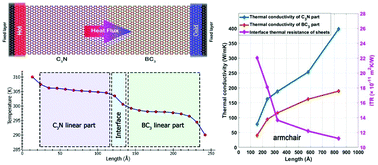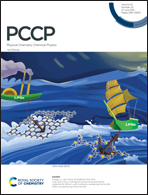Thermal conductivity and interfacial thermal resistance behavior for the polyaniline–boron carbide heterostructure
Abstract
In this paper, by employing non-equilibrium molecular dynamics simulations (NEMD), the thermal conductance of the hybrid formed by polyaniline (C3N) and boron carbide (BC3) in both the armchair and zigzag configurations has been investigated. For this purpose, by creating superlattices with different periodic lengths (lp), the thermal conductivity of the entire hybrid at various lengths and also at infinity has been reported. In addition, the thermal conductivity of each sheet and also the interface thermal resistance (ITR) between them under various conditions have been computed and how this changes upon varying the length, width, temperature, uniaxial strain, point vacancy, and circular defects has been recorded and plotted. Based on our findings, the increasing length of the hybrid results in a higher thermal conductance owing to the higher thermal conductivity of each sheet and the lower amount of ITR. However, altering the width does not have a noticeable effect on the thermal transport if the periodic boundary conditions are applied. Moreover, the results revealed that the rising temperature and uniaxial strain reduced the thermal conductivity of each sheet, whereas the ITR increased by increasing the temperature. Also, studying the effect of the presence of defects on the thermal transport demonstrated that increasing the size of the defects or the density leads to considerably lower thermal conductivity of each sheet and also a higher ITR. Our results also revealed the thermal conductivity of hybrid C3N–BC3 can reach 506 W m−1 K−1, which is higher in comparison to other two-dimensional hybrid materials. This result provides valuable information on the thermal transport and phonon behavior for use in nanoelectronic and thermoelectric devices.



 Please wait while we load your content...
Please wait while we load your content...